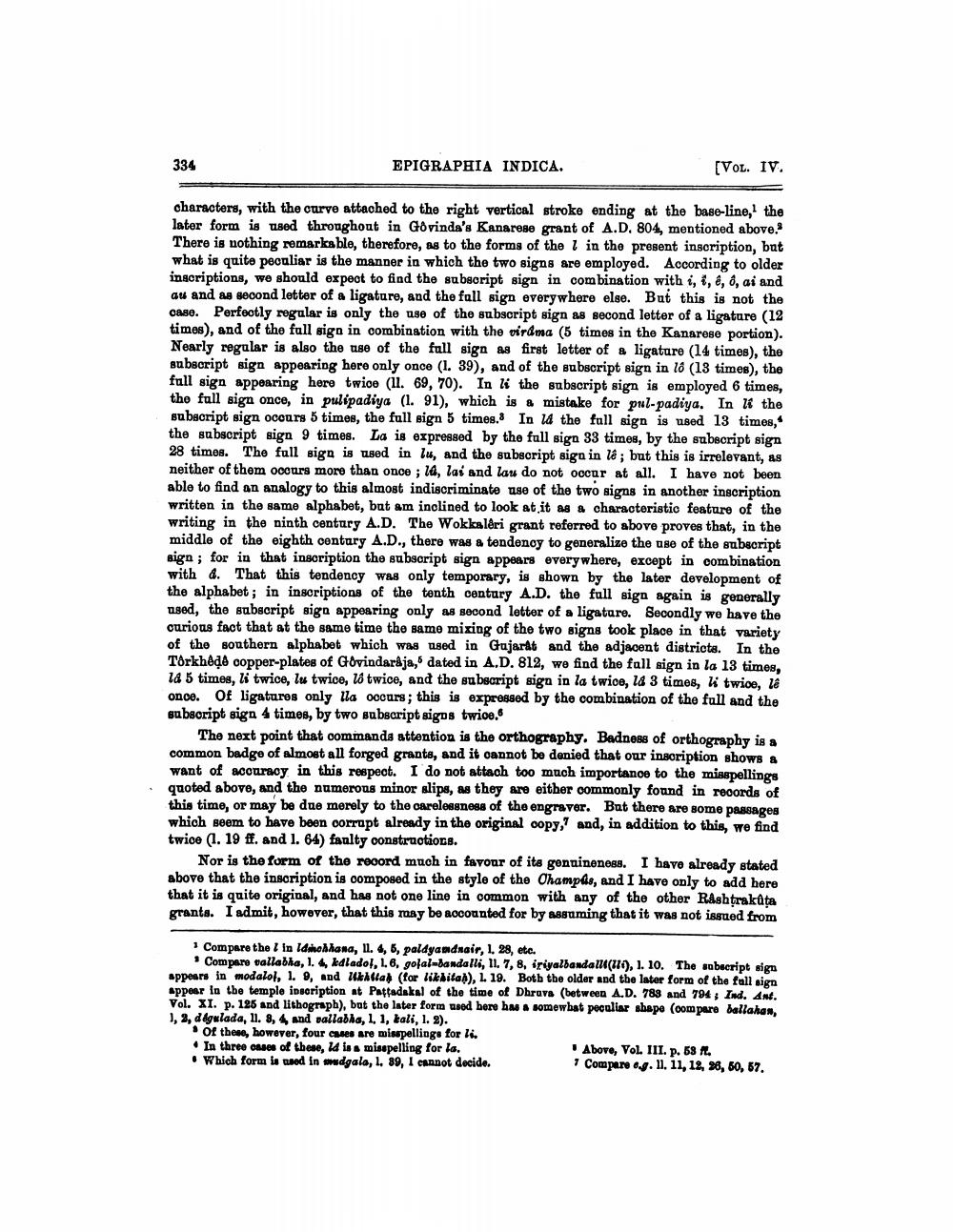________________
334
EPIGRAPHIA INDICA.
(VOL. IV.
characters, with the curve attached to the right vertical stroke ending at the base-line, the later form is used throughout in Govinda's Kanarese grant of A.D. 804, mentioned above. There is nothing remarkable, therefore, as to the forms of the l in the present inscription, but what is quite peculiar is the manner in which the two signs are employed. According to older inscriptions, we should expect to find the subscript sign in combination with i, , é, o, ai and au and as second letter of a ligature, and the fall sign everywhere else. But this is not the case. Perfectly regular is only the use of the subscript sign &s second letter of a ligatare (12 times), and of the full sigo in combination with the virama (5 times in the Kanarese portion). Nearly regular is also the tuse of the full siga as first letter of a ligature (14 times), the subscript sign appearing here only once (1. 39), and of the subscript sign in 18 (13 times), the full sign appearing here twice (11. 69, 70). In li the subscript sign is employed 6 times, the full sign once, in pulipadiya (1. 91), which is a mistake for pul-padiya. In l the subscript sign occurs 5 times, the full sign 5 times. In 14 the full sign is used 13 times, the subscript siga 9 times. La is expressed by the full siga 33 times, by the subscript sign 28 times. The full siga is used in lu, and the subscript siga in lê ; but this is irrelevant, as neither of them ooours more than once ; 14, las and lau do not oocur at all. I have not been able to find an analogy to this almost indiscriminate use of the two signs in another inscription written in the same alphabet, but am inclined to look at it as a characteristic feature of the writing in the ninth century A.D. The Wokkalêri grant referred to above proves that, in the middle of the eighth centary A.D., there was a tendenoy to generalize the use of the subscript sign; for in that inscription the subscript sign appears everywhere, except in combination with 4. That this tendency was only temporary, is shown by the later development of the alphabet; in inscriptions of the tenth century A.D. the full siga again is generally nised, the subscript siga appearing only as second letter of a ligature. Secondly we have the curious fact that at the same time the same mizing of the two signs took place in that variety of the southern alphabet which was used in Gujarat and the adjacent districts. In the Tôrkhede copper-plates of Govindaraja, dated in A.D. 812, we find the fall sign in la 13 times, la 5 times, li twice, lu twice, lô twice, and the subscript siga in la twice, lå 3 times, li twice, le once. Of ligatures only lla occurs; this is expressed by the combination of the full and the subscript sign 4 times, by two subscript sigos twice.
The next point that oommands attention is the orthography. Badness of orthography is a common badge of almost all forged grants, and it cannot be denied that our inscription shows & want of accuracy in this respect. I do not attach too much importance to the misspellings quoted above, and the numerous minor slips, as they are either commonly found in records of this time, or may be due merely to the carelessness of the engraver. But there are some passages which seem to have been corrupt already in the original copy, and, in addition to this, we find twice (1. 19 ff. and 1. 64) faulty constructions.
Nor is the form of the record much in favour of its genuineness. I have already stated above that the inscription is composed in the style of the Champds, and I have only to add here that it is quite original, and has not one line in common with any of the other Rashtrakata grants. I admit, however, that this may be accounted for by assuming that it was not issued from
1 Compare the I in Idahodhana, ul. 4. 6. paldyandsair. 1. 28. ete.
• Compare vallabha, 1. 4, kdladol, 1.6, golal-bandalli, 11. 7, 8, iriyalbandal (un), 1. 10. The subscript sign appears in modalol, l. 9, and Allah (for likhitaj), L. 19. Both the older and the later form of the fall sign appear in the temple inscription at Paftadakal of the time of Dhruva (between A.D. 789 and 794 ; Ind. Ant. Vol. XI. p. 126 and lithograph), but the later form used bere has somewhat peculiar shape (oom para ballahan, 1, 2, degulada, 11. 8, and vallabha, 1, 1, kali, 1. 8).
of these, however, four cases are misspellings for li. • In three one of these, 14 iss misspelling for la.
Above, VOL III. p. 58 it. • Which form is used in adgala, 1. 89, I cannot decide.
1 Compare e.y. 11. 11, 12, 26, 50, 57.




